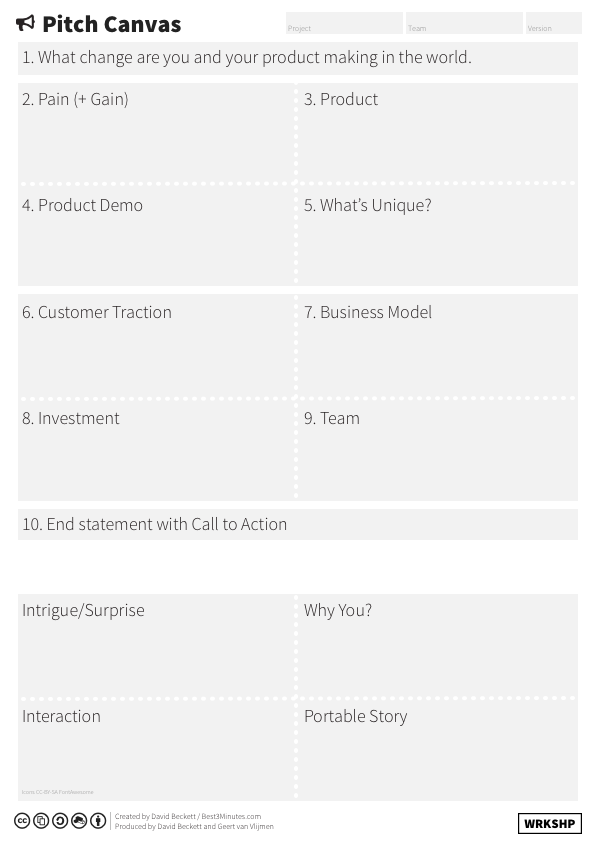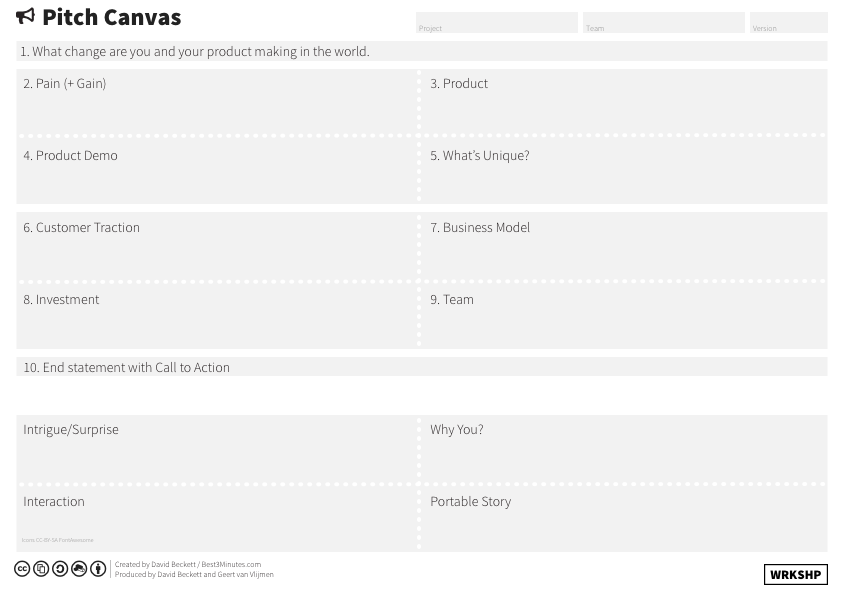Pitch Canvas
The Pitch Canvas © was created by David Beckett to help startups design better pitches. Its building blocks help you structure your story and shows which questions to answer to have a successful pitch. The Pitch Canvas © is used by numerous Startups, Accelerators and Corporates to develop innovative, winning pitches.
Use this tool when:
- you want to build a compelling pitch
- you need to convince investors or other stakeholders
Overview
| Time | ± 60 minutes | |
| Difficulty | 4 / 5 | |
| People | 2 - 5 | |
| Author | david beckett | |
| Website | https://best3minutes.com | |
| License | CC BY SA 4.0 |

What is it and when should I use it?
The Pitch Canvas © is a brainstorming tool developed by David Beckett that helps you visualise your entire pitch on a single page. That makes it easy to get the structure right (just follow the proven 10 steps) and it helps you and your team focus on the right questions and bring together the right content.
Pitch to win.
- David Beckett
In any innovation journey there is going to be a time when you need to convince others, be it stakeholders, investors, or prospective co-founders, of what you're doing. Maybe you want to enlist their support, or you would like them to invest in your company. In those situations, you'll likely need to come up with a pitch.
Tip! This tool helps you build and structure your pitch. Of course, that is just one part of the equation. The other part is delivering it. Telling you how to do that is beyond the scope of this website. We advise you to follow David Beckett's amazing course at Best3Minutes.com.
Tool Overview

What change are you making? A simple statement of the change you and your product are making in the world, wrought into a memorable one-sentence explanation.
Pain (+ Gain) What is the problem that you are trying to solve? What opportunities do you provide?
Product As simple as possible, what does your product do for customers? How does it work? Have you tested it with customers?
Product Demo Live demo (risky!), screenshots, or a physical product. Can you show a real customer using it? Do you really need a demo?
What's unique? What is unique about your product? What technology, relationships, or partners do you bring to the table? How are you different from competitors?
Customer Traction Did you have any successes so far? Are customers lining up? Did you do a beta or a pilot? What did customers say? Did you have any PR coverage?
Business Model How do you get paid? What is the opportunity for growth? How will you scale?
Investment What is the amount of investment you need? How many rounds? How many investors? What type of investor?
Team What relevant experience does your team have that supports your story? What were their achievements and successes?
End statement with Call To Action What would you like your audience to do after they hear your pitch?
Intrigue/surprise Don't give the whole game away – leave them wanting to know more. What is your cliffhanger? What surprising facts and new information will intrigue them?
Why you? Why do you care about solving this problem for your customers? How has your life been affected by this industry and business? Why should your audience get involved with you?
Interaction What challenge questions do you have for your audience? What do you think they might ask you?
Portable Story What story can the audience go away with and tell on your behalf? What do you want them to remember about you and your company?
Steps
1 Define your goal
You're about to design a pitch. Not a pitch deck, and not a powerpoint. A pitch is not a bunch of slides, it's a compelling story. And to get started, you really need to know what your goal is with this pitch. It can be tempting to shoe-horn multiple goals into your pitch, but try to resist and have one main goal.
Next, try to step into your audience's shoes: why would they care about your goal? And who are they, anyway? Spend five minutes do write a short profile of your audience.
- Who is in the audience?
- What do they care about?
- What are they trying to achieve by listening to your pitch?
- What are their biggest challenges?
- What are they like? Are they conservative? Risk averse? Enthusiastic?
- Do they want to know how things work? Will they ask technical questions?
- Are they money focused? And if so, are they interested in reducing cost, finding more profit, or achieving 10x return on investment?
- Are they interested in social impact? The environment?
- What is their mindset? Are they detail oriented? Thinkers? Doers? Idealists? Practical minded?
- What is the next big step your audience can take to help you achieve your goal? What might make them take that step?
Tip! The Persona Canvas is a great tool to help you structure the profile(s) of your audience.
Warning! Make sure to find some evidence for the assumptions you (may) have made answering the checklist questions. Better safe than sorry: can you find evidence online or by talking to other founders that helps you understand your audience better? Do you know someone that pitched to them before?
2 Define the Pain, Product, Product Demo, and Uniqueness
(We skip the topmost statement of the change you're making – don't worry, we'll come back to it later)
- Pain (+Gain): With your team, come up with ~5 sticky notes that define the pains and gains your customers have. Preferably, describe pains and gains you have already validated. Add some research to it: how many people have this problem? How much do they spend on it?
- Product: In ~5 post its, describe your product. What does it do for your customers? Make sure this relates to the pains and gains you just described.
- Product Demo: If you have something you can show, an MVP, or a demo, take some time to think about how you might show it off. What is its best feature? How does it showcase the product?
- What makes it unique?: How is your product or solution unique? Why is it hard to copy? Why is it going to dominate the market?
3 Traction, Business Model, Investment, and Team
The next part is mostly about the numbers. Here, you'll need to present your business case, and why it is a good investment.
- Customer Traction: To support your pitch, it helps to show that you already have enthusiastic, preferably paying, customers. Showcase this by explaining any results of sales or experiments, what people's feedback on your product was, and if you got any press coverage.
- Business Model: Next, explain how you are going to make money. How does your business work? How do you get revenue? What are the costs involved? What will it look like when the business will grow? How will you scale?
- Investment: What investment do you need to achieve the growth and revenue you presented with your business model? How many investors are you looking for? How many rounds? What type of investors?
- Team: What relevant experience does your team have that supports your story?
4 The end and the beginning
Finally, it is time to look at the end and the beginning of the pitch. Your pitch should end with a call to action: what do you want your audience to do after they heard your pitch? Cross check this with the 'next big step the audience can take' you wrote down in step 1. Did you provide all they need to make that step?
The last thing to do is to look at the beginning of your pitch. Now that the entire structure stands, you have some time and headspace to craft a one-line sentence that explains what you do for your customers. This sentence should be descriptive - but more than that, it should bring curiosity and excitement. It is the 'movie trailer' of your pitch. Steve Jobs was a master of crafting such sentences.
The iPod. 1000 songs in your pocket.
- Steve Jobs
5 Bonus Sections
The bottom part of the canvas contains four more building blocks that you can use to strengthen your story. They don't directly feature as part of your story, but they can serve as a 'landing zone' to brainstorm puzzle pieces to use in the rest of the canvas.
- Intrigue/Surprise: Your audience likely contains seasoned investors, entrepreneurs, or board members. They have seen it all before. In order to capture their attention and engage them you need to come up with something that will intrigue them or surprise them.
- Why You?: In this pitching process, you'll be scrutinised in detail about your capability of bringing this project to a success. You'll need to argue why you, personally, and your team are the right people to make it happen. Will you stick it out for the duration? Do you have a personal drive to solve the problem that guarantees your persistence?
- Interaction: To engage your audience even more, try to incorporate some interaction. Do you have challenges or questions to them? And, just as important, what questions do you expect them to ask? How can you best answer them?
- Portable Story: When your audience members leave the room, how will they talk about your pitch to others? What is the memorable hook that they can easily relate to others?
6 Next Steps
When you've filled your pitch canvas with a story, that's when the most important part of building a pitch comes: testing it. You'll need to test it both to practice and to learn where you need to improve it.